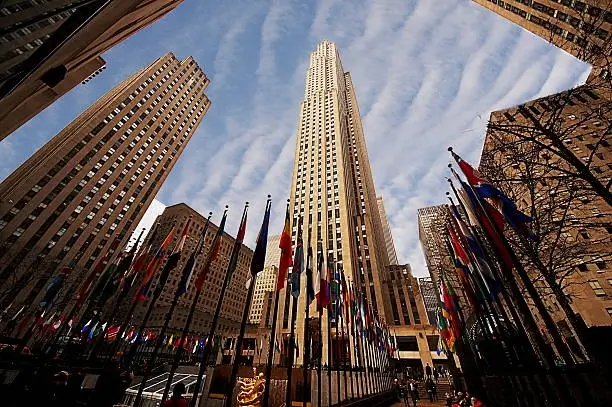A Brief History of Rockefeller Center

BCP Real Estate Group is proud to be headquartered at historic Rockefeller Center. Envisioned by John D. Rockefeller, Jr., as a “city within a city,” Rockefeller Center contains millions upon millions of square feet of leasable office space. Today, people flock to 30 Rock – one of several buildings on the site – to take in sweeping views of the city from “Top of the Rock.” However, many are not aware of the site’s rich history. Read on below for a brief overview of the history of this fascinating slice of New York.
The 22 acres upon which Rockefeller Center now sits were initially developed around 1801 to become New York’s first botanical gardens, the Elgin Botanic Gardens, which operated until 1811. Roughly 10 years later, the land was acquired by Columbia University; however, the school moved its main campus to Morningside Heights around 1900, so it didn’t have any practical use for it and had no plans to develop it.
In 1926, the Metropolitan Opera started its search for a location for its new opera house. However, when plans for the opera house were finalized, the university realized that it could not afford them. John D. Rockefeller, Jr., stepped in to assist, offering his support. Ultimately, Columbia University agreed to lease the land to Rockefeller for 86 years at the cost of $3 million per year. All told, the initial costs of acquiring the land, razing existing structures and building the first ones totaled around $250 million. The Metropolitan Square Corporation was formed in December 1928 to manage the project.
The day before the stock market crashed, October 28, 1929, the architects were assigned to the project by developer John R. Todd. This pivotal moment in history wreaked havoc on the world economy; ultimately, the Met was forced to abandon its plans for a new opera house on the site. Rockefeller sprang quickly into action, ultimately coming up with an idea for a “city within a city,” a mass media entertainment complex that would be anchored by RCA, NBC and RKO.
Early on, proposed names for the complex included Rockefeller City, Radio City and Metropolitan Square – a nod to the original plans for the new Metropolitan Opera House. The Rockefeller family was reluctant to have its name on the project but was persuaded to because the name recognition would be a bigger lure for tenants. The name officially changed to Rockefeller Center in December 1931. By 1937, only Radio City Music Hall retained the original name, Radio City. It was just as well since the complex quickly became popular with print media and “moving picture” media.
To make way for the new complex, nearly 230 buildings were razed, and more than 4,000 tenants had to relocate. Construction of the first buildings, the music hall and Center Theatre, started between September and November 1931. All told, plans called for the construction of 14 buildings. All of them were designed with limestone facades; in December 1931, an order for 14,000,000 cubic feet of Indiana limestone was placed – the largest such order at the time.
The RKO Building, the first completed, opened in September 1932. Radio City Music Hall opened three months later. The following year, construction of a new road, Rockefeller Plaza, began; it would continue through 1937. December 1933 marked the first time the famous Christmas tree was put up in the plaza center. It has since become a cherished tradition that is beloved by people around the world.
Several other milestones quickly followed. The ice skating rink replaced unpopular retail space at the site in 1936, and it continues to be a popular wintertime destination. In November 1936, construction of the 36-story Time and Life Building was finished. Rockefeller placed the ceremonial final rivet for the project on November 1, 1939. All told, the project employed 40,000 to 60,000 workers.
By the fall of 1939, the site boasted more than 26,000 tenants, and it received more than 125,000 visitors per day. By 1941, Rockefeller Center was almost completely leased; in 1944, 99.7% of its 5,290,000 square feet of space was filled. This led to demands for expansion, and such work continued throughout the 1940s into the 1950s. The Time-Life Building opened in 1956; during the 1970s, the Exxon Building, the Celanese Building and the McGraw-Hill Building were all added. In 1985, Columbia University sold the land for $400 million; two years later, Rockefeller Center became a National Historic Landmark.
Today, Rockefeller Center consists of two building complexes – the original 14 Art Deco buildings from the 1930s and four towers along the Avenue of the Americas that were built during the 1960s and 1970s – and one standalone building across 51st Street, which was built in 1947. All told, the complex boasts more than 17,000,000 square feet of leasable office space. Top of the Rock, its popular observatory, is located in what was originally called the RCA Building. Its name changed to the GE Building and then the Comcast Building before assuming its current name, 30 Rock.




